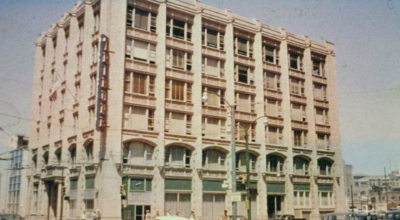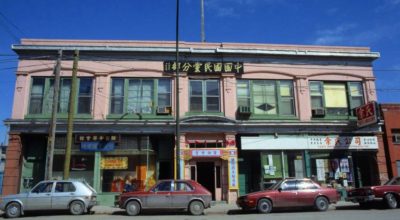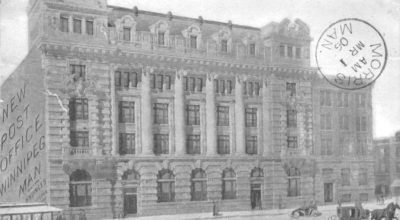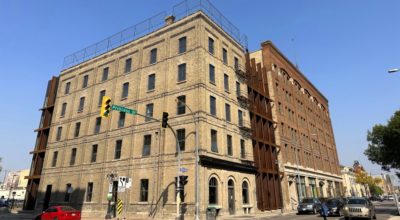
/ Blog
March 10, 2021
Built & Natural Heritage at Risk: Chapman School Property
Chapman School was originally built in 1913, one year after the Rural Municipality of Charleswood was organized. The early Chapman School was destroyed by fire in 1916, and after being rebuilt, burned down a second time on April 23, 1943. The current Chapman School building was constructed in 1944, showing characteristics of wartime restraint. Designed by the Scottish Architect Edgar Prain, who also had a part in designing St. John’s Anglican Cathedral (1926), Chapman School featured a raised basement and numerous windows to increase the amount of light and fresh air entering the building. The school received an expansion in 1974.
Chapman School was named after George Thomas Chapman. Chapman and his family lived on Lot 28 in Charleswood starting in 1899. The land he lived on was sold to the city in 1973 to become part of Assiniboine Park. This means his house, which was the oldest in the area, was torn down in 1974. Mr. Chapman was an active part of the community, involved in many aspects of civic life as well as the school board. As the Charleswood community was in its infancy and while Mr. Chapman was alive, his involvement included areas such as St. James and the Rural Municipality of Assiniboia.
Charleswood was an independent municipality that only became a part of Winnipeg in 1972. It was a very rural community until urban sprawl started after the Second World War ended. Charleswood has strong ties to the Métis and Indigenous communities. For years before colonialism took place, there were well known trails that passed through what is now Charleswood, used for both trade and travel. The proximity to the Assiniboine River made it easy to cross, it was known as “The Passage” that is where Southboine Drive and Berkley Street meet. Today, this is commemorated by Kelly Landing Park.
Although a number of notable individuals were involved with Chapman School, as administrators and teachers, one of the earliest recorded principals is particularly interesting: Hilda Grace Sparrow. Sparrow’s term as principal of Chapman School was cut short in 1941, when she enlisted in the Canadian Women’s Air Force Auxiliary – she was discharged as a Squadron Leader in 1945 at the end of the war.
Children’s education during the Second World War was quite different than what you might see at an elementary school today. In 1944, when the current Chapman School building was constructed, children’s school life was consumed, like many other things, by the war raging in Europe. Children were taught about their duties as a citizen, including participating in the war effort: many children raised money for local war funds, or bought war stamps to put in albums. They were shown films from the National Film Board like Home Front (1940), about the women’s war effort, or Food, Weapon of Conquest (1941), showing the forcible appropriation of food from European countries by the advancing German army.
“In 1939, the Principal of the Brandon Normal School, Clarence Moore, wrote that the objective of education was ‘to produce a generation of informed, thinking, and socially disposed citizens..'”
While children were taught to be “informed, thinking, and socially disposed citizens”, they were also taught prejudiced material, in particular against Indigenous people. While non-Indigenous children were learning about the fur trade, contemporary Indigenous children were being forced to attend the horrific residential schools. And while many children were learning about heroes in the war effort, one of Canada’s most decorated veterans, Tommy Prince, was overlooked because he was Ojibwe. Prince was one of only three Canadians to hold the Military Medal and the Silver Star – in all, Prince collected eleven different military medals for his heroic contributions in WWII and the Korean War.
The end of the Second World War heralded the beginning of a new period in world history, Canadian history, and Winnipeg history. Men and women came home from the deadliest war in history looking forward to the future, to modernism, and an optimistic future. Veterans coming home from Europe and farther overseas, were offered free university educations – and were also having children at a rate that was so distinctive, that it would come to be known as the “Baby Boom”. During the Boomer years, Chapman School had to accommodate a larger and larger numbers of pupils, so that in 1955 the high school grades were moved to Charleswood Collegiate. A few years previous in 1951, Chapman School had been incorporated into Charleswood Consolidated School No. 2327.
The school almost shut down in 2008 and then again in 2011. It had the smallest population of any public school in Winnipeg, which meant it also had one of the highest operating costs per student. The building was also old and was in need of repairs. The largest repair was the Vulcan boiler that was original to when the school was built in 1944. The Provincial Public Schools Finance Board found in 2011, that the school was not worth the costs of repairs and that demolishing it would be the best option, but then mysteriously Chapman School was saved in 2011.
The school operated through until 2016, after which it was unofficially closed due to low enrolment. The school only had 51 students in 2016 and it was the wishes of the parents that the children be transferred to Royal School which was roughly a kilometre away. Royal School was newer and had more students but not nearly at capacity. The Pembina Trails School Division agreed to the proposal but for a while Chapman School was not officially closed, due to Manitoba’s moratorium on school closures. The school hosted a farewell open house on Friday, June 17, 2016.
The building stood empty for a while and in an interesting twist on the state of many heritage buildings, Chapman School retains many of its original interior features, whereas the external elements have undergone significant changes over the years. Chapman School is currently not a designated heritage building, nor is it on the nominated or commemorative list. A City of Winnipeg report by the Historical Buildings Committee states that:
“The Chapman School is historically important in that it is one of the oldest public educational structures in the Charleswood area. It was designed by a noted local architect and much of the interior space has remained unaltered, although the exterior has suffered significant alteration”
In the first half of 2018, the Pembina Trails School Division was set to sell Chapman School and the associated green space to Karma Developments. The Chapman School Community Residents Committee, realizing the building itself would be difficult and unlikely to be designated as a heritage site, looked into the history of the green space which was part of the Chapman School property. They found, with help from Heritage Winnipeg, that a portion of the Chapman School property was historically significant as part of one of the original primary Métis land grants, and has served its designated purpose as a community recreation space for the past 105 years.
These land grants, commonly called scrips, were issued to Métis families in the 1870’s in Manitoba. The basic idea of scrips were to have each individual Métis family sign away their claim to the land as Aboriginal people, in return they would receive a coupon redeemable for their choice of either money, or a specific parcel of land. Scrips are comparable to treaties in that they were the federal government’s tool to take away Aboriginal land titles so they could offer the vast prairie lands to settlers from Europe. The Manitoba Métis Federation estimates that around 75% of Métis families lost their scrip through questionable government handling of scrips at all levels.
As part of one of these homesteads given to a Métis families through the scrip system, the green space at Chapman School is a vital part of this history, and has the potential to be designated as a historic site. Heritage Winnipeg has been working with the Chapman School Community Residents Committee to try and get the property designated as a heritage site. After this effort began, Karma Developments rescinded their bid for the property.
Plans also fell through to sell the building to Iglesia Ni Cristo for continued use as a green space by the church, and also by the community. 2016-2017 saw the building used by Westgate Mennonite Collegiate for use as temporary classroom space during a renovation project. Finally in 2019, the property was sold to Tuxedo Lands Inc. for $2.41 million. There are still talks of turning the property into condos and loosing all the heritage property. However, Dasmesh School Winnipeg, an independent Sikh school is currently renting the property to use for their school. They appear to be happy with the building and as long as they stay, the longer the heritage community can advocate for heritage protection.
THANK YOU TO THE SPONSOR OF THIS BLOG POST:

Written by Heritage Winnipeg.
SOURCES:
"Canada. Department of Northern Affairs and National Resources" | Our Legacy
"Chapman Principal: ‘This School was a Gift’ | Canstar Community News - Alana Trachenko - June 21, 2016
"Chapman School One Step Closer to New Life" | CTV News Winnipeg
"Chapman to become 'ghost school' after students, teachers leave" | CBC News - April 29, 2016
"Charleswood" | Winnipeg Architecture Foundation
"Decision on Chapman School Property Postponed" | Canstar Community News - Alana Trachenko - May 7, 2018.
"Food, Weapon of Conquest" | Stuart Legg - National Film Board of Canada
"G.T. Chapman, Pioneer, Dies" | Winnipeg Tribune - December 31, 1940, Page 13.
"Historic Sites of Manitoba: Chapman School No. 1677" | Manitoba Historical Society
"Historic Sites of Manitoba: The Passage" | Manitoba Historical Society
"Historic Sites of Manitoba: Royal School" | Manitoba Historical Society
"Home Front" | Stanley Hawes - National Film Board of Canada
"Manitoba's Only Sikh School Finds Room to Grow in Charleswood" | Winnipeg Free Press - August 31, 2019, Page 36.
"Memorable Manitobans: Edgar Prain" | Manitoba Historical Society
"Memorable Manitobans: George Thomas Chapman" | Manitoba Historical Society
"Memorable Manitobans: Hilda Grace Sparrow" | Manitoba Historical Society
"Métis Scrip" | Camie Augustus - Our Legacy
Métis Scrip Records | Library and Archives Canada
Page 11 | Winnipeg Tribune - October 20, 1941, Page 11.
"Parent's Move Closes School in Charleswood" | Winnipeg Free Press - April 30, 2016. Page 38.
"Parkland Purchase Approved" | Winnipeg Free Press - December 20, 1973, Page 57.
"School's Boiler on Its Last Legs" | Winnipeg Free Press - February 3, 2012.
"Tiny School Faces Wrecker" | Winnipeg Free Press - May 28, 2011, Page 42.
"Tommy Prince" | Laura Neilson Bonikowsky - The Canadian Encyclopedia
Winnipeg 100 | Winnipeg Free Press, 1973
"Wood For War (1941/1942)" | Library and Archives Canada











